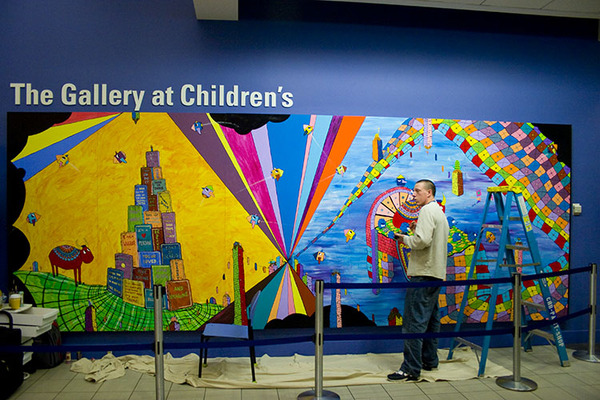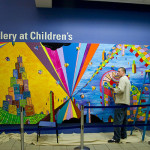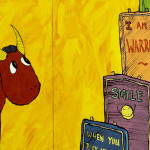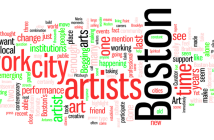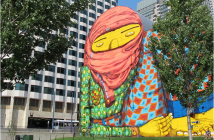Some of the most unforgettable moments from our childhood come from visits to the hospital. Those of us who made it through our formative years without a memorable trip to the emergency room still spent a great deal of time fretting about the white walled rooms with nothing between ourselves and another ill stranger but a thin pale sheet. We remember pain, fear, and quiet, caring parents, but little color, if any. Even the shimmer of a television screen from your roommate’s bedside was a reprieve in the week-long hours we spent convalescing under limestone-colored lighting.
A 52-foot long, seven-foot high mural would have been nice, also, which is what Children’s Hospital has in its main lobby, and if any kids aren’t able to make the trip from their floor, the hospital’s Art for Kool Kidz program sets up artist visits to bring the art to the patients. The hospital also owns and displays a rotation of over 3,000 originals artworks, many of which were donated to the institution.
For the last seven months, the one-and-a-half bus-length wall was occupied by a surreal narrative painting by the Cambridge-based artist and author Caleb Neelon. The work is populated by several Lilman’s (or ‘Lilmen’), a character from a children’s book that the artist wrote and illustrated, in addition to stubby rocket ships with eyes, a couple shark-like creatures, an elephant suspended by a hot-air balloon, and a bull, who Caleb said “might be on a little trip - whether it’s to a hospital or to a sudden, very general unknown - not knowing what to expect.”
Caleb painted the mural’s vividly rendered characters and scenes from left to right, and without any sketches (not even for the hospital’s administration), a process not unlike storytelling, and did so within a two-week period during normal business hours. Jessica Finch, the hospital’s Art Coordinator who enlisted Caleb for the project, said in an interview that she doesn’t believe she would have been able to install the piece if it wasn’t painted inside the hospital itself because it’s so boisterous.
“[B]ecause people are involved in the process,” she said, “and [the hospital]knows it’s not going to be here forever, I think [they’re] loving it. It’s a different situation than if I were to put this in a waiting room where people would worry about whether the work would give [patients]a headache.”
To his credit, Caleb did need his paints to effectively compete with Hannah Montana and Elmo Mylar balloons (pictured on right in this photo), as he noted while he painted. “All you can do is go bigger,” he said.
Caleb also solicited inspirational messages from patients and painted them into a multi-color card-castle structure, one message per card. Many of the notes were intended to be inspirational, and as Caleb suggested, probably similar to the words many parents have for their children when they begin to undergo treatment at the hospital. “Don’t be scared” and “Be brave” were both popular messages that visitors to Children’s wanted to share with their fellow wounded and ill, but one message from a 16-year-old cancer patient, named ‘Jack,’ who for the time Caleb was working in the lobby was too weak to deliver any messages to him. “Jack's parents took some pictures of the mural,” the artist recollected on his blog, “and brought them up to him, telling me they'd bring back his message, which some hours later they relayed: ‘I am a warrior.’” When Jack returned to the hospital for outpatient procedures and check-ups, he always stopped by the mural while it was there. The work was, as Jack’s mother later informed Finch, “empowering” for the cancer patient.
Finch explained that “patients aren’t… supposed to interact with each other, and a lot of the time they’re not even supposed to leave their rooms… so there’s this isolation that happens. “[P]eople really appreciate some way to communicate… and that can be really helpful [to them].”
A young girl who was about 11 and had been coming to Children’s regularly for two years approached the mural with her mother one day close to the work’s completion. Her stature belied her age, but she made up for her size with a couple prodigious insights. She said she liked the
pattern and colors of Caleb’s creations and “the way they go together.” Her thoughts were spot on, as the muralist’s bright blues and yellows seem to simultaneously kick each other from the surface of the work. The young patron added that the work “inspires the imagination, like, to go places,” just as Caleb had intended.
Other patients and parents approached the working artist as well. A mother from Cape Cod with a son in surgery for a broken elbow and a teenaged woman who had been coming to the hospital for 13 years were among the gazers, but Caleb was notably inspired by a young boy, about 10 years old, who spends his days in a wheelchair and sped around the hospital with the help of a joystick. While looking at the art in the lobby and conversing with Caleb, the young man described how his wheels could be a paint brush, an extension of his self but also good clean fun. In the lobby there is also work by the quadriplegic artist Tommy Hollenstein, who has perfected a similar technique to the boy’s. Caleb watched as the bright light of discovery flashed in the mind of wheel-chair bound young man as he first saw the Hollenstein paintings and giddily retold the instance of the boy’s inspiration as “one of those little magic moments.” Caleb wrote more about meeting the boy in detail on his blog, The Art Where Dreams Come True.
Many of Children’s staff and long-term inpatients became attached to Caleb’s mural in the same way - one might say - as a child who requests the same story to be read to them at bedtime over and over, but like many of the maturing patients who had benefited from the intricate, yet humongous, painting, it had growing pains. There was a demand to see the work by the internationally recognized artist outside the walls of the hospital. Emily Isenberg, a spokesperson for the Art for Kool Kids program, organized an exhibition for the work at the Fourth Wall Gallery beginning May 12. It is a short walk from Children’s Hospital, but out from under the long shadows of the hospitals in the Longwood medical area. Despite the mural’s location in the hospital’s main lobby, it is be difficult to draw people off the street, or even into a neighborhood comprised of several blocks of hospitals, to see art.
“I feel pretty strongly,” Isenberg wrote in an email, “that it is going to be hard to publicize our program without doing off-site exhibitions now and again because of the general public's awkward, mixed emotions with seeing an exhibit at the hospital.”
The Fourth Wall exhibition also includes the sale limited edition t-shirts and bags for the benefit of the Art for Kool Kidz program in addition to a “Family Day” event where visitors to the gallery can paint their own messages to the patients of Children’s Hospital with Caleb. Despite the hospitals efforts, there is irony in that bringing the mural out into a more “public” place will give it less continuous exposure and limit its ability to make an impact on its surroundings and viewers. There is a disparate impact that any mural can have on the visitors to a gallery versus the patients in a hospital’s lobby, even withholding the content of this particular mural. Caleb says he’s always looking for new ways to work in the public, is an artist whose work may be best suited where foot traffic is continuous.
“The graffiti writer in me really likes big public sites,” he said while adding some of the final details to the mural at Children’s, “It’s hard to tell unless you’ve been here and sat here for hours, but very few places will get this kind of traffic and, of course, it’s open 24-seven.”
Caleb said “if you want to dig really deep into it and get all Freudian, you could say that painting big just keeps me feeling like a kid because I’m just blowing the scale up to make me feel that size again.” This analysis of his own work offers some help for adults who have forgotten what it’s like to be a kid. Caleb said that when he was young, he was always fascinated by murals.
Now his own works occupy walls from Children’s Hospital in Boston to Kathmandu in Nepal. Though a former graffiti artist, his execution could never meet the perfect curves and fades of the best graffiti writers, so he created a style that’s slightly reminiscent of a technicolor bus in Kashmir or Guatamala - perhaps inspired from his worldwide study of street art - mixed with a children’s book aesthetic: large-eyed animals, fuzzy, amoebic figures, and neatly built rock cairns upon which various creatures sit in bird nest-like heaps of sticks.
It may come as no surprise that Caleb’s work will soon be occupying almost 3,000 square feet of wall space within a few minute’s walk from the where he began painting at Children’s in September 2009. On April 24, the MFA opened Signs and Symbols, a mural installed in a highly trafficked lobby, for which Caleb worked with 125 7 to 12-year-olds from all over Boston. Each of the children created a letter to album-sized placard that was inspired by a broad historical study of text and its common pairings with images. The increased interactivity of the production, a collaboration method similar to the one he made use of for the Imagination Wall, filled up a 40-foot by 13-foot wall of messages that the artist put together. On the other side of Huntington Avenue, in the Mission Hill neighborhood, Caleb recently completed a work at the Tobin K-8 School similar to, but much larger than, his Children’s Hospital mural that was nominated for the Boston Phoenix’s and New England Journal of Aesthetic Research’s best Public Work of Art. Though behind the school, the outdoor mural faces the Mission Church park where hundreds of kids (and their parents) will see it every week.
He is humble about the feedback he gets from the kids he paints for. After I questioned him about some of the commentary on his work by patients at Children’s he said, “You know, I can really only do my thing, and trust my work. I just have to take it on faith in myself that what I do will be relevant to someone else,” and later added, “Kids have always dug what I’ve done, and oftentimes when adults didn’t.”
Caleb later said one of the best pieces of advice he’s even been given is to “Pay attention to the people who are paying attention to you.”
- Neelon at work on the Imagination Wall at Children’s Hospital in September 2009. (image credit: Christian Holland)
- Imagination Wall (detail). The message “I am a Warrior” was submitted for Neelon to paint into the mural by a teenage cancer patient at the hospital. (Photo by Christian Holland/taken while work was in process)
- Neelon’s mural at the Maurice J. Tobin K-8 School in Boston’s Mission Hill neighborhood. (image credit: Caleb Neelon)
The Imagination Wall at the Fourth Wall Project
The Art for Kool Kidz program at Children's Hospital.
"Signs and Symbols: The Community Arts Initiative Artist Project" is on view through September 6, 2010 in the Linde Family Wing - Community and SMFA gallery at the Museum of Fine Arts, Boston.
"The Imagination Wall" is on view from May 12 through May 28, 2010 at The Fourth Wall Project.
Caleb Neelon's website, The Art Where Dreams Come True.
All images are courtesy of the artist unless otherwise specified.

